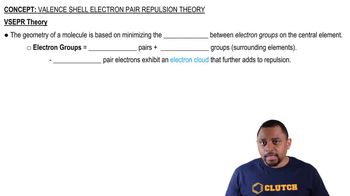Which of the following statements are true? c. A 𝜋 bond is made from the sideways overlap of two p orbitals.
Ch.9 - Molecular Geometry and Bonding Theories
Chapter 9, Problem 57b
(b) What is the hybridization of the carbon atoms in each molecule?
 Verified step by step guidance
Verified step by step guidance1
Identify the number of sigma bonds and lone pairs around each carbon atom in the molecule. Sigma bonds can be formed with other carbon atoms or with atoms of different elements such as hydrogen, oxygen, etc.
Use the sum of sigma bonds and lone pairs to determine the steric number of each carbon atom. The steric number is crucial as it indicates the number of hybrid orbitals needed by the carbon atom.
Apply the steric number to determine the hybridization of the carbon atom: If the steric number is 4, the hybridization is sp3. If the steric number is 3, the hybridization is sp2. If the steric number is 2, the hybridization is sp.
Repeat the process for each carbon atom in the molecule to ensure all are accounted for.
Consider the molecular geometry or shape that results from the hybridization to verify if the determined hybridization matches the observed structure.

Verified video answer for a similar problem:
This video solution was recommended by our tutors as helpful for the problem above.
Was this helpful?
Key Concepts
Here are the essential concepts you must grasp in order to answer the question correctly.
Hybridization
Hybridization is a concept in chemistry that describes the mixing of atomic orbitals to form new hybrid orbitals. These hybrid orbitals are used to explain the geometry and bonding properties of molecules. For example, in methane (CH4), the carbon atom undergoes sp3 hybridization, resulting in four equivalent sp3 hybrid orbitals that arrange themselves tetrahedrally.
Recommended video:
Guided course

Hybridization
Molecular Geometry
Molecular geometry refers to the three-dimensional arrangement of atoms within a molecule. The geometry is determined by the number of bonding pairs and lone pairs of electrons around the central atom, which influences the hybridization state. Understanding molecular geometry is crucial for predicting the shape and reactivity of molecules.
Recommended video:
Guided course

Molecular Geometry with Two Electron Groups
Valence Bond Theory
Valence Bond Theory (VBT) is a fundamental theory that explains how atoms bond by overlapping their atomic orbitals. According to VBT, the formation of a covalent bond occurs when the orbitals of two atoms overlap, allowing for the sharing of electrons. This theory provides the basis for understanding hybridization and the resulting molecular shapes.
Recommended video:
Guided course

Valence Shell Electron Pair Repulsion Theory
Related Practice
Textbook Question
Textbook Question
Which of the following statements are true? d. A 𝜋 bond has two regions of overlap on opposite sides of the internuclear axis.
Textbook Question
(b) Imagine that you could hold two atoms that are bonded together, twist them, and not change the bond length. Would it be easier to twist (rotate) around a single s bond or around a double 1s plus p2 bond, or would they be the same?
Textbook Question
Propylene, C3H6, is a gas that is used to form the important polymer called polypropylene. Its Lewis structure is (a) What is the total number of valence electrons in the propylene molecule?
Textbook Question
Ethyl acetate, C4H8O2, is a fragrant substance used both as a solvent and as an aroma enhancer. Its Lewis structure is
a. What is the hybridization at each of the carbon atoms of the molecule?
